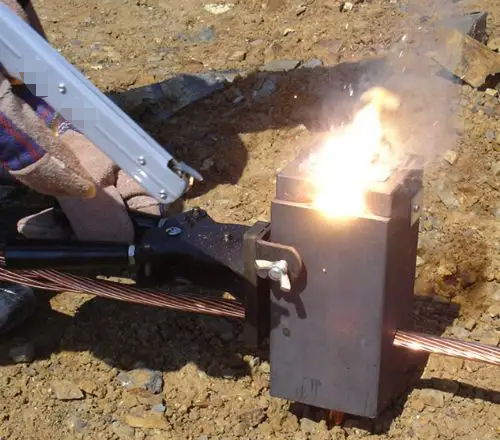The Use Of The Exothermic Welding Process Has The Following Unique Advantages
(1) The current-carrying capacity (melting point) of the solder joint is equal to that of the wire, and the contact resistance value is small.
(2) Because the welded joints are molecularly bonded, there is no contact surface and There is no mechanical pressure, so there is no relaxation and no increase in electrical resistance and corrosion resistance.
(3) When welding, a permanent molecular bond, is not easy to loosen and does not increase the resistance, has strong corrosion resistance.
(4) The welding joint can be unaffected by corrosive products like copper.
(5) The welding joints can withstand repeated multiple high inrush (fault) currents without degradation.
(6) The welding method is simple and practical, and the operator can easily get on the job after simple training.
(7) The material for exothermic welding is light and easy to carry.
(8) No external power or heat source is required to perform welding.
(9) The quality of the weld can be verified by its appearance.
(10) Exothermic welding can be used to weld copper, copper alloys, copper-plated steel, and various alloy sheets of steel including stainless steel materials.
The grounding network of communication systems in large petrochemical companies nowadays is generally integrated with the grounding network of the whole plant, and the exothermic welding method ensures "noiseless" connections in digital communication systems. The general mechanical connection causes electronic noise, and sudden changes in the connection point can cause high Ldi/dt voltages because the sudden change can cause pulses coupled to the signal circuit, which can cause erroneous data or even permanent damage to the circuit.
However, The Exothermic Welding Process Also Has Influencing Factors That Affect The Welding Results
(1) The most important step that must be taken when welding is to prevent the generation of water and gas within the welded joint during the welding process. Because a good welded joint should have a full and bright surface, and no porosity, after cutting and observing its profile in a whole without porosity and defects, as the mold, welding powder, and the welded object may adsorb moisture, the most important influencing factor affecting its welding effect is moisture or water vapor.
(2) Another factor that affects the welding effect is the cleanliness of the mold and the welded object. If the surface of the welded object has dust, grease, oxide (rust) or other adhesions must be completely removed and made clean and bright after the welding operation, otherwise the electrical conductivity and mechanical properties of the welded joint will be affected.
If the residue left in the welding mold is not completely removed, it will cause the surface of the welded joint to be not smooth and shiny. Therefore, preventing moisture generation, cleaning the welded object, and cleaning the mold are the key factors affecting the welding effect.
Copper steel alloy grounding rods are relatively simple grounding rods for general applications, which are made of a certain thickness of copper overlaid on a carbon steel core rod. The length is 1.5m, 2.5m, and 3m, and other specifications.
The high-strength steel core facilitates the construction of the grounding rod directly into the ground, making the construction faster; the copper covering layer on the surface can strengthen the conductivity and drainage capacity of the grounding rod and enhance the corrosion resistance of the electrode so that the grounding resistance of the grounding system remains stable for a long time and prolongs the service life of the grounding system.
The connection of the copper steel alloy grounding rod and other grounding bodies in the grounding network adopts an exothermic welding method that can effectively reduce the contact resistance value at the welding point.

The Effect Of Exothermic Welding In Grounding Systems
In a company's 800,000 tons/year ethylene project, the production plant uses a common grounding device, i.e., work grounding, protective grounding, lightning grounding, anti-static grounding, and computer grounding connection at the same time, forming a common grounding network, so the grounding resistance value is required to be less than 1Ω. If the construction is carried out with conventional galvanized flat steel and angle steel, in order to make the grounding resistance meet the requirements, the number of grounding electrodes must be increased way.
And the use of copper-clad steel grounding electrode, grounding wire grounding system, if you can not effectively solve the connection If the contact resistance of the connection point is too large, it will not be able to meet the requirements.
After repeated research and demonstration, it was finally decided to adopt the grounding system consisting of copper-clad steel grounding electrodes and copper-clad steel grounding wire. The connection between the grounding wire and the grounding electrode is all adopted by exothermic welding methods. The basic operation procedure of this new grounding connection method is very simple, and the site construction personnel only need a short time to master this welding technology.
Although the use of copper-clad steel grounding system relative to the traditional galvanized steel grounding system one-time investment increased a lot, the later maintenance and repeat input is greatly reduced, thus from the economic analysis can be seen using the exothermic welding process of the new grounding one-time investment is higher than the traditional grounding way, but from a long-term perspective its overall investment and the traditional grounding way equivalent.
At present, the use of copper-clad steel grounding electrodes, and grounding wire grounding systems has been widely used in the petrochemical industry, and exothermic welding technology has also been increasingly used in the petrochemical industry, thus solving the problems that common grounding network construction of the grounding connection point contact resistance value is high, resistance reduction difficulties, site construction difficulties, and short service life of grounding system.



